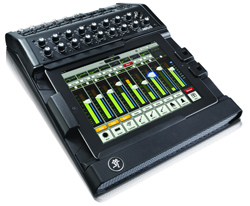
INSTILLING CONFIDENCE
We also wanted to give the user detailed control and information, which is often a weak point for traditional UI designs because they are limited by the hardware (i.e., precision of the V-Pot encoder, number of LEDs, available space for silkscreen printing, etc.).
Plus, hardware controls often have to pull double duty. An LED ladder might need to show EQ gain and aux level, which will require multiple silkscreens so the user knows what’s what. There is also the issue of recall.
Other low cost digital mixers don’t have moving faders. The user needs to physically move the fader against a light or meter that shows desired position. Nothing dampens the “cool factor” of recall more than this. It can provide a full-color EQ curve where the user can grab a node or simply draw in a curve.
There are no shared controls and everything about the UI has the right feel and right labeling with the high-resolution control and display that users desire.
Addressing customer confidence in a completely touch-controlled mix environment was also important. During the early stages of design, it was clear that some users were concerned about accidentally changing the wrong control. A lot of this was due to preconceptions, as they subsequently used the app and shed those concerns. However, it was worth a serious look.
To address this, we developed the “Grow and Glow” concept for the Master Fader app. Every adjustable parameter “Grows” and “Glows” when touched, which provides positive feedback that you’re controlling what you intended.

GOING MOBILE
The ability to control the mix wirelessly has obvious benefits. And since the iPad is acting as a control surface and not processing anything, up to 10 iPad devices can control a single mixer. A monitor engineer can be easily added, and musicians can even control their own monitor mixes on stage.
Each iPad has control over the entire mixer, or, access can be limited independently for each iPad. Proper password control is critical and setting up a dedicated network is certainly encouraged.
We were firm that the setup must not require a computer (aside from the iPad, of course). The thought of needing to drag a laptop and additional cabling to a gig just seemed wrong.
Instead, we developed a solution that only involved a simple wireless router. Deciding to make this optional not only helped to get the price right for the consumer, it made sense for users who simply didn’t need this functionality.
If we had gone with an integrated wireless design, the DL1608 price point would have gone up considerably; much more than a third-party Wi-Fi access point costs the consumer.
One can easily imagine the DL1608 concept scaling up, scaling down or adapting for recording applications. At the time of this article, the DL1608 is gearing up for international availability to meet a substantial amount of orders.
And while we’re not ready to announce anything now, be sure that we are focused on fostering this technology and pushing the boundaries even further in the future.
Ben Olswang is a product manager with Mackie.
